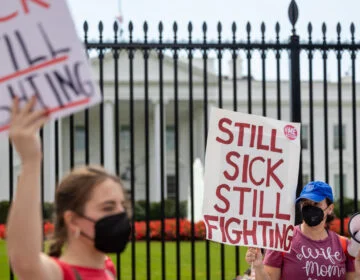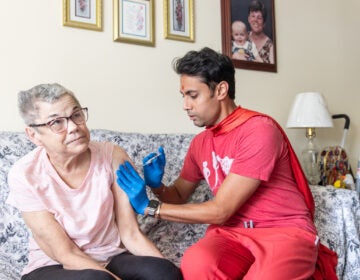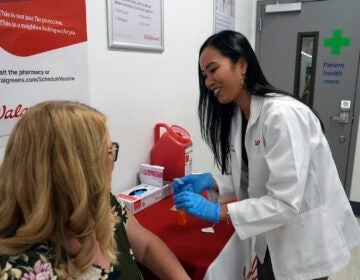I’m immunocompromised. How does a mask protect me if no one else wears one?
Lifted mandates leave a lot of risk calculations up to immunocompromised individuals, for some of whom vaccines aren’t much help.
Listen 3:51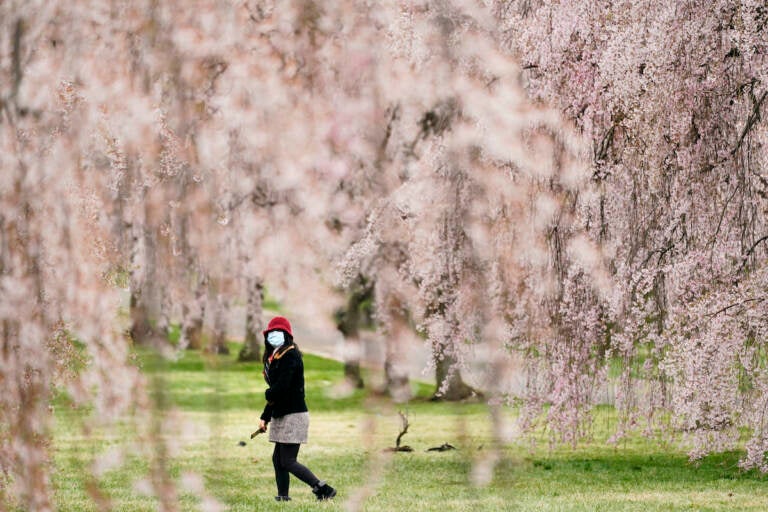
A person wearing a face mask as a precaution against the coronavirus walks amongst blooming cherry trees on a spring day at the Fairmount Park in Philadelphia, Friday, April 9, 2021. (AP Photo/Matt Rourke)
This is one of a series of articles in which reporters from WHYY’s Health Desk Help Desk answer questions about vaccines and COVID-19 submitted by you, our audience.
Maggie McGinn has been living in isolation in her parents’ home in Philadelphia’s Roxborough section for about two years. She had to give up her apartment when the coronavirus hit, after she applied for disability and was rejected.
McGinn, 44, works virtually as a children’s librarian for the Joseph E. Coleman Library in the city’s Germantown section. Since August 2021, she’s visited the library just four times, all while terrified of coming down with COVID-19. She has post-treatment Lyme disease syndrome, which created an immune deficiency. Because of it, McGinn suffers from chronic kidney disease and stomach, sinus, and nerve issues.
“I’m terrified about work,” she said last week, as accommodations that benefited immunocompromised people were being rolled back locally and nationally, including vaccination requirements, flexible working options, and mask requirements. McGinn is waiting for her employer, the Free Library of Philadelphia, to announce full, in-person hours again and to start requiring employees to come in five days a week.
The Centers for Disease Control and Prevention is no longer recommending masks indoors in areas it considers “low risk.” In areas of “medium risk,” it advises those who are at high risk of illness to “talk to [their] health care provider about additional precautions, such as wearing masks or respirators indoors in public.” More than half of Pennsylvania’s counties fall into that category, including Bucks, Erie, Monroe and Montgomery counties.
Philadelphia dropped its indoor mask mandate on Wednesday, following a drop in Philly’s COVID metrics. Delaware dropped its indoor mask mandate for businesses and schools.
In New Jersey, face masks are no longer required for vaccinated people in outdoor public spaces or indoor spaces. New Jersey health officials recommend, but do not require, that residents mask while indoors in places where they do not know that everyone is vaccinated.
For immunocompromised individuals like McGinn, the advice is: Wear a mask, even as you’re surrounded by those who don’t.
Living amid the unmasked
Some experts say that one-way masking works for vaccinated and boosted people geared with N-95 masks. Yet the new CDC guidelines also leave a lot of decisions up to individual immunocompromised people, many of whom are either not protected by the COVID-19 vaccine or unsure of how much protection it provides.
Roughly 7 million Americans have been left behind in the nation’s efforts to get back to normal. About 3% of U.S. adults take drugs that suppress their immune systems. Millions more are like McGinn, who have conditions or genetic disorders that hamper immunity.
Weakened immune systems are not prepared to fight COVID-19 the way healthy systems are, even after vaccination. Many immunocompromised people remain at high risk of severe illness and death from COVID-19.
That strikes home for McGinn. Her immune system went haywire after she got her second dose of the vaccine last summer, and her Lyme disease syndrome symptoms accelerated.
She wonders: What’s the rush for these new CDC guidelines? Why not wait just a few more weeks, until the risk is even lower?
Many people don’t realize the risks that are mounting for the immunocompromised, she said. “Because normal, healthy people don’t care enough … to put up with a few more weeks of mask wearing.”
Now, she said, she can’t count on a sense of “communal responsibility” to keep her safe.
“Maybe we’re just not meant to make it,” said McGinn. “I’m getting left behind. I feel like we’re looking at extinction of part of the species, but nobody’s paying attention.”
Before the pandemic, McGinn said, she was already susceptible to illness. As a children’s librarian, she would get colds when interacting with a new class of kids. But her colds, unlike the average person’s cold, would knock her out for a couple of weeks.
She said she is still recovering from a 2016 case of pneumonia that caused her to be placed in a medically induced coma. “And so if I got COVID, they’re pretty sure I would die,” McGinn said, referring to her immunologist. “They’re pretty sure I’m not in any kind of condition to fight it off.”
McGinn was a healthy, three-sport varsity athlete in high school. After spending most of her free time near the Wissahickon Creek, she was bitten by a tick. She now treasures the sparse moments when she has enough energy for activity. She went skiing in March 2021 for the first time in 10 years.
“I’m basically debilitated, and people don’t realize that. This is not just about the immunocompromised people. This is about the 10% of healthy people who will get this disease and never recover,” she said, alluding to people who will get long COVID-19 and experience long-term symptoms not so different from hers.
Dr. Larry Saltzman, 68, has a 12-year history of chronic lymphocytic leukemia. As an immunocompromised individual, he plans on making the same choices that he’s made throughout the pandemic.
He is still going to avoid crowds, avoid grocery shopping, avoid shaking hands, and avoid things like the movie theater on a Saturday night.
“I’m not going to live as a hermit, in total fear of this,” said Saltzman. “I’m going to believe that 60 to 70% of the American population is now immunized, either through vaccinations or infections. And I’m going to be careful about it.”
Salzman, executive research director for the Leukemia & Lymphoma Society, was most recently treated with CAR T-cell therapy, which kills cancer cells but also kills cells that make antibodies to the COVID-19 vaccine.
He said the decisions left up to immunocompromised people are nothing new.
“For better or worse, everybody’s got to gauge their risk,” said Saltzman. “Once things started to open up, the decision was always up to us, the individual.”
A public health viewpoint
Dr. Usama Bilal, assistant professor in the Urban Health Collaborative and the Department of Epidemiology and Biostatistics at Drexel University’s Dornsife School of Public Health, said the CDC’s one-way masking recommendation reminds him of a statement by Texas Lt. Gov. Dan Patrick, in 2020.
Patrick suggested that elderly people were willing to die from COVID-19 to save the economy.
“What he was saying is, ‘These people have lower value to society, so they can die,’” said Bilal. “That’s the same thing as eugenics, assigning value to people intrinsically.”
This individualistic approach, leaving immunocompromised people to “fend for themselves,” is not effective, Bilal said, and sends the message that they don’t have the right to participate in society fully.
“Apart from leading to a higher number of deaths, it will lead to a very unequal distribution of those deaths,” Bilal said.
To him, Bilal said, the CDC recommendations are an abandonment of what public health should be about, protecting the public as a whole, not each individual, and especially the most vulnerable.
Those who have the resources to protect themselves, the wealthier, able-bodied, younger, whiter, more educated, those who can remain working from home, said Bilal, “that’s the people that can protect themselves without help from public health.”
With every disease, the communities most affected follow social, class, and racial patterns because they stem from the same “underlying unequal distribution of resources,” Bilal said. Those who don’t have access to pharmacies in their neighborhoods, or access to primary care physicians, access to PPE, those who cannot take time off to get their second vaccine dose or their booster shot are on that list.
Who has a primary care physician to talk to for advice? Bilal was infuriated by that piece of the CDC’s recommendations, which he said is inherently exclusionary.
According to Bilal, the number of people who are getting their care at urgent care clinics is increasing, while the number of people who are using primary care is decreasing.
“Are people going to go into an urgent care clinic to ask a doctor there something and then get charged a $100 co-pay? Is that what we are asking people to do? That doesn’t make any sense at all,” he said.
There is some hope for extra protection for immunocompromised individuals who don’t react well to the vaccine. Many are awaiting AstraZeneca’s Evusheld, an antibody therapy developed to prevent COVID-19 — rather than treat it — in people who can’t make their own virus-fighters. But the U.S. government has purchased only 1.2 million doses, and only 500,000 of those have been distributed.
Who will get those doses? Who has access to more COVID-19 tests? Those are the questions on Bilal’s mind. His answers, again: those who have easiest access to pharmacies, doctors, and time off.
“We are privatizing the response to COVID,” he said, when the country needs to turn toward a more collective view of public health. More specifically, he said, that includes more federal paid sick leave for everyone, more affordable housing so the COVID-19 risks that come with overcrowding decrease, and more worker protection laws, so, for example, workers can complain about not being given PPE without getting fired.
He also said there need to be clearer “on-ramp” structures for implementing COVID-19 mitigation measures. Those measures, he said, should be based on case numbers, not hospitalizations.
McGinn said she, too, wants clearer, more transparent information.
“Be direct and open about things, don’t infantilize us,” she said. “Say, `Look, here’s the situation, here’s what we think, we’re going to do our best to save you but it might just be you’re not meant to be saved.’”
If she’s “doomed,” McGinn said, she will be able to come to terms with it if there is transparency from decision-makers.
“For people like me, knowledge is power and control, and we don’t have a whole lot of definite knowledge,” said McGinn. “So if you’re giving up on us, tell us you’re giving up on us and let us react and make our plans accordingly. Because maybe I would go out to Colorado and see my dad while he’s out there, because I’m going to die anyway.”
It’s all about the power to make decisions for her future, she said: “How do I plan, what do I plan for? Do I save? What am I saving for?”
WHYY is your source for fact-based, in-depth journalism and information. As a nonprofit organization, we rely on financial support from readers like you. Please give today.


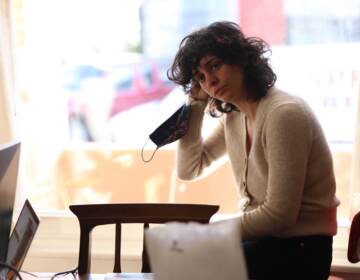

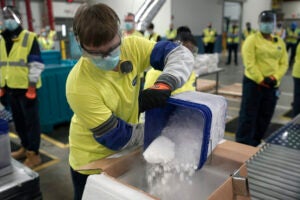
![CoronavirusPandemic_1024x512[1]](https://whyy.org/wp-content/uploads/2020/03/CoronavirusPandemic_1024x5121-300x150.jpg)
